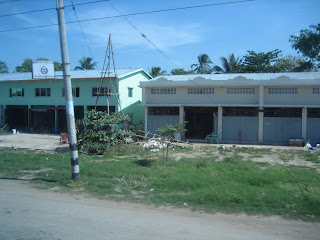




We left Rangoon at 330 pm as the tide rushed in. The trip to the mouth of the river takes about three hours. There’s not much to see on either side of the river except flat farm land. From here it’s about 1000 miles or two sea days to reach the Indian peninsula. We entered Colombo Harbor in the am. Sri Lanka is not much different than Burma in climate. The port is the usual jumble of old warehouses. We elected to go on a mission to paint a school in an outlying village about 20 miles from the city. We were greeted by the local officials and they had assembled the children to perform a welcoming parade. We enjoyed some tea and things to munch on before we set to work(picture). The exterior of the school really needed a cleaning rather than a fresh coat of heavily watered paint. The representative of the non-governmental organization which had arranged this project, as well as the school’s principal, were on hand to thank us. After lunch, more painting, and a small presentation, we headed back to the port. I am skeptical about the utility of these kinds of projects. Having worked with Global Volunteers and the Pathologist Group, it’s clear some projects are useful and others(perhaps most), contrived and ineffective. The recipients are generally looking for anything they can get that doesn’t cost them too much.Props! Action!(Out on display are the beautiful and innocent children dressed in traditional garb, doing(picture)traditional dances!)The NGO’s are eager to show themselves useful as the caring and prudent mediators between donors and recipients. Cameras!The donors are generally Westerners looking to demonstrate their good will, genuinely want to improve the world, and/or unburden their guilt. Is this kind of handout more effective than the efforts and decisions the local people could do on their own? I doubt it. What the town really needs is a system that generates the dollars necessary to maintain the school. For example, there were no toilets at the school we could use. In the end we got to see a small (not very poor) village and their children, and I must say they were rather good-looking and healthy, and prepared to be able-bodied adults.
The ship arrived in Cochin, India the next morning and we decided to visit the St. Francis church (picture) and the synagogue. Vasco de Gama died here and was originally buried in the wall of the church.His body was later returned to Portugal. The church is the oldest one in India, dating from the mid 1500’s. Over the years it has seen different Christian denominations practiced within. Today it no longer serves a strictly Catholic congregation. There’s a monument to World War I dead in front. From there we visited the Chinese fishing nets (picture) deployed in the harbor’s inlet. We went to see the old synagogue. We had never been inside. In 2004, we saw the clock tower(picture) before its recent renovation. The tower abuts a compound containing the synagogue. Photos of the compound were not allowed. The Jewish presence in India dates to the Roman Era, following destruction of the Jerusalem Synagogue and subsequent diaspora. Other groups of settlers appeared in India following the European expulsions. Finally, the British rule attracted Bagdadi Jews seeking relief from decadent Ottomans. With the establishment of the modern Israeli state, most of the young Jewish people have left Cochin. Mumbai is next on our itinerary.




















